17 hours ago
June 21, 2023, 6:30pm ET
Click here to see ISW’s interactive map of the Russian invasion of Ukraine. This map is updated daily alongside the static maps present in this report.
Click here to access ISW’s archive of interactive time-lapse maps of the Russian invasion of Ukraine. These maps complement the static control-of-terrain map that ISW produces daily by showing a dynamic frontline. ISW will update this time-lapse map archive monthly.
Note: The data cutoff for this product was 1pm ET on June 21. ISW will cover subsequent reports in the June 22 Russian Offensive Campaign Assessment.
Ukrainian forces conducted counteroffensive operations on at least three sectors of the front on June 21. Ukrainian Deputy Defense Minister Hanna Malyar stated on June 21 that Ukrainian troops had partial success during offensive operations in the Bilohorivka-Shypylivka direction (about 10km south of Kreminna in Luhansk Oblast).[i] A Russian milblogger additionally claimed that Ukrainian forces are counterattacking in the areas south and west of Kreminna.[ii] The Ukrainian General Staff reported that Ukrainian forces continued offensive operations in the western Donetsk-eastern Zaporizhia Oblast border area on the Vilne Pole-Makarivka line, and Russian milbloggers continued to discuss Ukrainian attacks in this area, particularly south of Velyka Novosilka.[iii] Ukrainian and Russian sources reported that Ukrainian troops continued offensive operations in western Zaporizhia Oblast, both south and southwest of Orikhiv and that Russian forces are counterattacking to regain lost positions in this direction.[iv] Russian sources noted a relatively slower pace of Ukrainian offensive operations in both western Donetsk and western Zaporizhia oblasts compared to the previous days.[v]
Ukrainian President Volodymyr Zelensky acknowledged that the progress of Ukrainian counteroffensives has been slower than expected, likely due to effective Russian defenses. Zelensky stated that Ukrainian counteroffensive progress has been “slower than desired” and will take time.[vi] Zelensky noted that Ukrainian advances are not easy because Russian forces have mined 200,000 square kilometers of frontline territory.[vii] Russian President Vladimir Putin also addressed ongoing Ukrainian counteroffensives and preposterously claimed that Russian forces have destroyed 244 tanks and 679 armored vehicles since these operations began on June 4.[viii] Russian forces’ doctrinally sound defense in western Zaporizhia Oblast and prepared defensive positions throughout southern Ukraine are likely slowing Ukrainian advances, as ISW has previously assessed.[ix] A Russian milblogger claimed that Russian defensive positions in southern Ukraine, dubbed the “Surovikin Line” after former overall theater commander Army General Sergei Surovikin, consist of several defensive zones between lines along dominant elevated positions up to 30km into Russian held territory.[x] The milblogger claimed that the “Surovikin Line” consists of a forward line of defense with several dozen platoon and company strongholds, and a main defensive line roughly 25km back with minefields, anti-tank ditches, and other defensive structures in between, though the extent of these defenses along the entire front line is unclear.[xi] These Russian defensive lines are likely arrayed to enable a first echelon of Russian forces, deployed to the forward defensive line, to slow advancing Ukrainian forces while a second echelon of forces deployed closer to the main defensive line launch counterattacks against any Ukrainian breakthroughs, as well as providing prepared fallback positions for frontline Russian units.[xii] Localized Ukrainian territorial gains are unlikely to immediately disrupt these Russian defensive lines and localized Ukrainian attempts at rapid breakthroughs are less likely to degrade these lines than a wider concerted operational effort, one which may be focused on degrading Russian defenders and fixing reserves rather than the immediate liberation of territory.
The overall slower than expected pace of Ukrainian counteroffensive operations is not emblematic of Ukraine’s wider offensive potential, and Ukrainian forces are likely successfully setting conditions for a future main effort despite initial setbacks. Ukrainian officials have long signaled that the Ukrainian counteroffensive would be a series of gradual and sequential offensive actions and have more recently offered the observation that currently ongoing operations do not represent the main thrust of Ukraine’s counteroffensive planning.[xiii] Ukrainian Deputy Defense Minister Hanna Malyar emphasized on June 20 that it is not useful to gauge the success of military actions based "solely by kilometers or the number of liberated settlements.”[xiv] Malyar’s statement echoes Ukrainian President Volodymyr Zelensky’s observation that war is not a ”Hollywood movie” that will deliver immediate and tangible results.[xv]
The observation that current Ukrainian operations may have objectives that are not simply territorial is an important one. Ukrainian forces may be conducting several offensive operations across the entire theater in order to gradually attrit Russian forces and set conditions for a future main effort. Losses are inevitable on both sides, but careful operational planning on the Ukrainian side likely seeks to mitigate and balance this reality with the equally important observation that the degradation of Russian manpower is a valuable objective. Wagner Group Yevgeny Prigozhin voiced his concern that Russian forces are suffering major manpower and equipment losses as a result of ongoing Ukrainian attacks, especially in southern Ukraine.[xvi] The success of Ukrainian counteroffensives should not be judged solely on day-to-day changes in control of terrain, as the wider operational intentions of Ukrainian attacks along the entire frontline may be premised on gradually degrading, exhausting, and expending Russian capabilities in preparation for additional offensive pushes.
Ukrainian defense industry conglomerate “Ukroboronprom” announced on June 20 that Ukraine built and successfully tested a 1,000km-range drone, indicating Ukraine’s intent and ability to target Russian military infrastructure in Russian-occupied territories and Russia with Ukrainian-made drones.[xvii] Ukroboronprom Spokesperson Nataliya Sad stated that Ukrainian forces successfully used the new Ukrainian-made drone but did not provide information on whether this drone was already used for strikes. Ukroboronprom previously announced its development of the 1,000km range drone in October 2022. Ukrainian Main Military Intelligence Directorate (GUR) Head Kyrylo Budanov told The Economist that Ukraine is at war and that drones over the Kremlin show that Russian defenses are “Potemkin villages” - an expression referring to the purported construction of fake settlements by a historical Russian minister to hide the true state of the Empire from the Tsar.[xviii] While Budanov did not confirm that the Ukrainian forces previously launched drones over the Kremlin on May 3, US intelligence officials previously assessed that the Ukrainian special military or intelligence units are behind a series of covert actions against Russian targets including the May 3 strike.[xix] ISW had previously incorrectly assessed the May 3 attack on the Kremlin may have been a Russian false flag.[xx] Ukraine’s focus on development of long-range drones alongside US intelligence indicates that Ukraine will likely continue to pursue Russian rear targets with Ukrainian-made drones. International law allows Ukrainian forces to strike legitimate targets even in Russian territory, especially targets from which Russian forces are launching attacks on Ukrainian civilian infrastructure.[xxi]
Russian occupation authorities continue to codify legal mechanisms for forcible deportations from occupied areas of Ukraine. Donetsk People’s Republic (DNR) Head Denis Pushilin signed an order on June 20 that creates a working group to regulate and oversee the creation of “temporary detention facilities for foreign citizens and stateless persons” in occupied Donetsk Oblast and designates these individuals as subject to expulsion or deportation from territory considered to be Russian under Russian law.[xxii] Russian President Vladimir Putin signed a decree on April 27 that presaged Pushilin’s order by defining those living in occupied areas who refuse to accept Russian passports as “foreign citizens and stateless persons currently residing in the Russian Federation.”[xxiii] The establishment of the new DNR working group essentially sets formal conditions for the DNR government to detain residents of occupied Donetsk Oblast who are classified as “foreign citizens and stateless persons” under the April 27 law and officially designate them as subject to deportation from occupied Donetsk Oblast. The working group will also likely serve as a coercive tool aimed at forcing residents of occupied areas to obtain Russian passports out of fear of arbitrary detention and potential deportation. ISW continues to assess that all lines of effort aimed at codifying and formalizing the deportation of Ukrainians may constitute a violation of the Geneva Convention on the Prevention and Punishment of the Crime of Genocide, as well as a potential deliberate ethnic cleansing campaign.
Key Takeaways
- Ukrainian forces conducted counteroffensive operations on at least three sectors of the front on June 21.
- Ukrainian President Volodymyr Zelensky acknowledged that the progress of Ukrainian counteroffensives has been slower than expected, likely due to effective Russian defenses.
- The overall slower than expected pace of Ukrainian counteroffensive operations is not emblematic of Ukraine’s wider offensive potential, and Ukrainian forces are likely successfully setting conditions for a future main effort despite initial setbacks.
- Ukrainian defense industry conglomerate “Ukroboronprom” announced on June 20 that Ukraine built and successfully tested a 1,000km-range drone, indicating Ukraine’s intent and ability to target Russian military infrastructure in Russian-occupied territories and Russia with Ukrainian-made drones.
- Russian occupation authorities continue to codify legal mechanisms for forcible deportations from occupied areas of Ukraine.
- Russan and Ukrainian forces continued to engage in positional battles along the Kupyansk-Svatove line.
- Ukrainian forces continued counteroffensive operations near Kreminna.
- Russian and Ukrainian forces continued limited ground attacks in the Bakhmut area and along the Avdiivka-Donetsk City line.
- Ukrainian forces conducted limited ground attacks along the administrative border between western Donetsk and eastern Zaporizhia oblasts.
- Russian and Ukrainian forces conducted limited ground attacks in western Zaporizhia Oblast.
- The Russian military command is reportedly forming a new Azov Naval District as part of the Russian Black Sea Fleet.
- The Russian State Duma passed a law in the third reading raising age limits for Russian contract personnel and officer, likely to keep personnel currently due to retire in the force.
- Russian occupation authorities continue to deport children from occupied Luhansk Oblast to Russia under the guise of medical necessity.
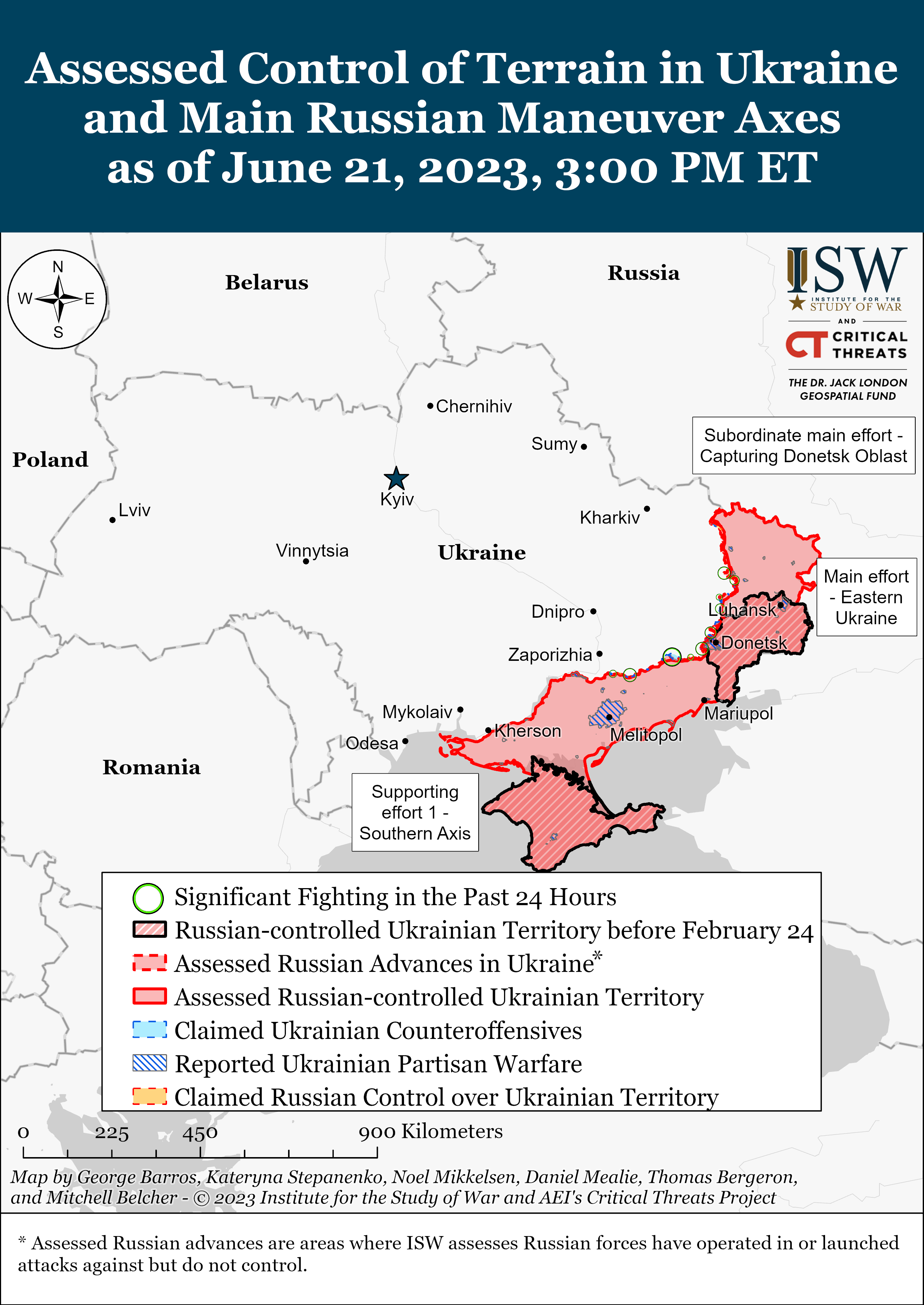
We do not report in detail on Russian war crimes because these activities are well-covered in Western media and do not directly affect the military operations we are assessing and forecasting. We will continue to evaluate and report on the effects of these criminal activities on the Ukrainian military and the Ukrainian population and specifically on combat in Ukrainian urban areas. We utterly condemn these Russian violations of the laws of armed conflict, Geneva Conventions, and humanity even though we do not describe them in these reports.
- Russian Main Effort – Eastern Ukraine (comprised of two subordinate main efforts)
- Russian Subordinate Main Effort #1 – Capture the remainder of Luhansk Oblast and push westward into eastern Kharkiv Oblast and encircle northern Donetsk Oblast
- Russian Subordinate Main Effort #2 – Capture the entirety of Donetsk Oblast
- Russian Supporting Effort – Southern Axis
- Russian Mobilization and Force Generation Efforts
- Activities in Russian-occupied areas
Russian Main Effort – Eastern Ukraine
Russian Subordinate Main Effort #1 – Luhansk Oblast (Russian objective: Capture the remainder of Luhansk Oblast and push westward into eastern Kharkiv Oblast and northern Donetsk Oblast)
Russian and Ukrainian forces continued to engage in positional battles on the Kupyansk-Svatove line on June 21. The Russian Ministry of Defense (MoD) claimed that Russian forces stopped three Ukrainian sabotage and reconnaissance groups near Synkivka (9km northeast of Kupyansk), Kotlyarivka, (27km northwest of Svatove), and Novoselivske (13km northwest of Svatove).[xxiv] Russian Western Group of Forces Spokesperson Colonel Sergei Zybinsky claimed that artillery units of the 6th Combined Arms Army (Western Military District) struck Ukranian troops near Vilshana (15km northeast of Kupyansk).[xxv] A Russian milblogger claimed that positional battles continue in the Kupyansk direction but that Russian forces cannot break through to the city.[xxvi] A Russian milblogger claimed that Russian forces are pushing Ukrainian forces out of Synkivka and are establishing a foothold on the right bank of the Oskil River.[xxvii] A Russian milblogger claimed that Russian forces continue to outmaneuver Ukrainian forces west of the R66 Svatove-Kreminna highway.[xxviii]
Ukrainian forces continued counteroffensive operations near Kreminna on June 21. Ukranian Deputy Defense Minister Hanna Malyar reported that Ukrainian forces conducted partially successful offensive operations in the Bilohorivka-Shypylivka direction (10km south of Kreminna) and have established themselves on newly captured frontlines.[xxix] The Ukranian General Staff also reported that Russian forces conducted unsuccessful offensive operations in the direction of Dibrova (5km southwest of Kreminna), Serebrianka (10km southwest of Kreminna), and the Kremmina-Yampolivka line (17km west of Kreminna).[xxx] Geolocated combat footage posted on June 20 shows Ukrainian forces repelling a Russian armored assault east of Spirne (25km south of Kreminna).[xxxi] A Russian milblogger claimed that Ukrainian forces unsuccessfully attacked towards Kremmina and that Russian forces continued advancing in the direction of Torske (14km west of Kreminna) and the Oskil River west of Kreminna.[xxxii] A Kremlin-affiliated milblogger claimed that the intensity of fighting increased on June 20, and Russian airborne (VDV) units occupied several Ukrainian strongholds in the Serebrianske forest area (10km southwest of Kreminna).[xxxiii] A Russian milblogger claimed that elements of Russia’s Central Group of Forces are conducting assault operations and repelling Ukrainian counterattacks in several areas near Kreminna.[xxxiv] The Russian milblogger claimed that Russian forces destroyed two Ukrainian sabotage and reconnaissance groups attempting to advance from the Terny direction (17km west of Kreminna).[xxxv] The Russian milblogger claimed that Russian artillery units repelled a Ukranian armored attack and forced a retreat near Dibrova and claimed that Russian artillery units repelled two Ukranian attempts to break through Russian lines in the Serebrianske forest area.[xxxvi] A Russian milblogger claimed that there is heavy fighting around Bilohorivka (12km southwest of Kreminna) in the Lyman direction.[xxxvii]
Russian forces are constructing unknown military infrastructure in occupied Luhansk Oblast. Satellite imagery published on June 20 shows the construction of unspecified military infrastructure on military grounds of the Luhansk People’s Republic (LNR), southeast of the occupied city of Khrustalnyi.[xxxviii]
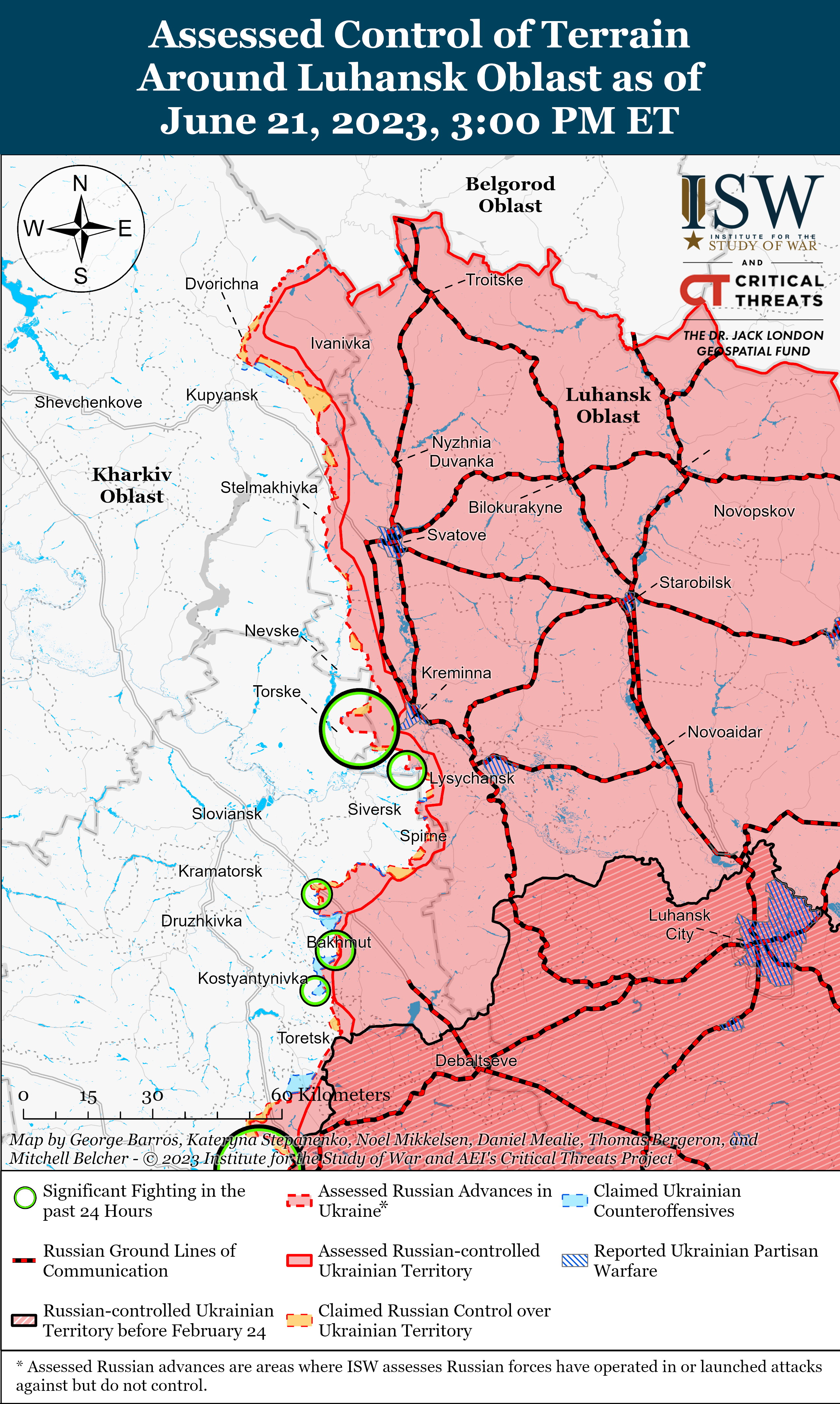
Russian Subordinate Main Effort #2 – Donetsk Oblast (Russian Objective: Capture the entirety of Donetsk Oblast, the claimed territory of Russia’s proxies in Donbas)
Russian and Ukrainian forces continued limited ground attacks in the Bakhmut area on June 21. The Ukrainian General Staff reported that Russian forces conducted unsuccessful offensive actions near Orikhovo-Vasylivka (11km northwest of Bakhmut), Ivanivske (6km west of Bakhmut), and Bila Hora (16km southwest of Bakhmut).[xxxix] Ukrainian Deputy Defense Minister Hanna Malyar stated that several combat engagements occur in the Bakhmut area daily.[xl] The Ukrainian General Staff reported that Russian forces deployed elements of the 83rd Guards Airborne Assault (VDV) Brigade to the Klishchiivka (7km southwest of Bakhmut) area to replace elements of the 31st Guards VDV Brigade that recently suffered heavy losses.[xli] A Russian milblogger claimed that Russian forces conducted unsuccessful offensive operations near Hryhorivka (9km northwest of Bakhmut).[xlii] The Russian Ministry of Defense (MoD) claimed that elements of the Southern Grouping of Forces repelled Ukrainian assaults near Vesele (20km northeast of Bakhmut).[xliii] Russian milbloggers claimed that Ukrainian forces conducted assaults north of Bakhmut near Yahidne (4km north of Bakhmut), Berkhivka (6km north of Bakhmut), and Orikhovo-Vasylivka and southwest of Bakhmut near Klishchiivka.[xliv] One milblogger claimed that the tempo of Ukrainian ground assaults near Berkhivka is declining and that Ukrainian forces have temporarily paused assaults near Rozdolivka (19km north of Bakhmut) to regroup.[xlv]
Russian and Ukrainian forces continued ground attacks along the Avdiivka-Donetsk City front on June 21. The Ukrainian General Staff reported that Russian forces conducted unsuccessful offensive actions near Avdiivka, Sieverne (6km west of Avdiivka), Pervomaiske (11km southwest of Avdiivka), Marinka (27km southwest of Avdiivka), and Novomykhailivka (36km southwest of Avdiivka).[xlvi] The Russian MoD claimed that elements of the Southern Grouping of Forces repelled Ukrainian assaults near Heorhiivka (29km southwest of Avdiivka), Pervomaiske, Krasnohorivka (22km southwest of Avdiivka) Vodyane (8km southwest of Avidiivka), and Marinka.[xlvii] Geolocated footage published on June 21 indicates that Ukrainian forces are operating in northern parts of Marinka that Russian sources previously claimed that Russian forces controlled.[xlviii] A Russian milblogger claimed that Russian forces also conducted assaults near Pobieda (32km southwest of Avdiivka) and made unspecified gains in the area.[xlix]
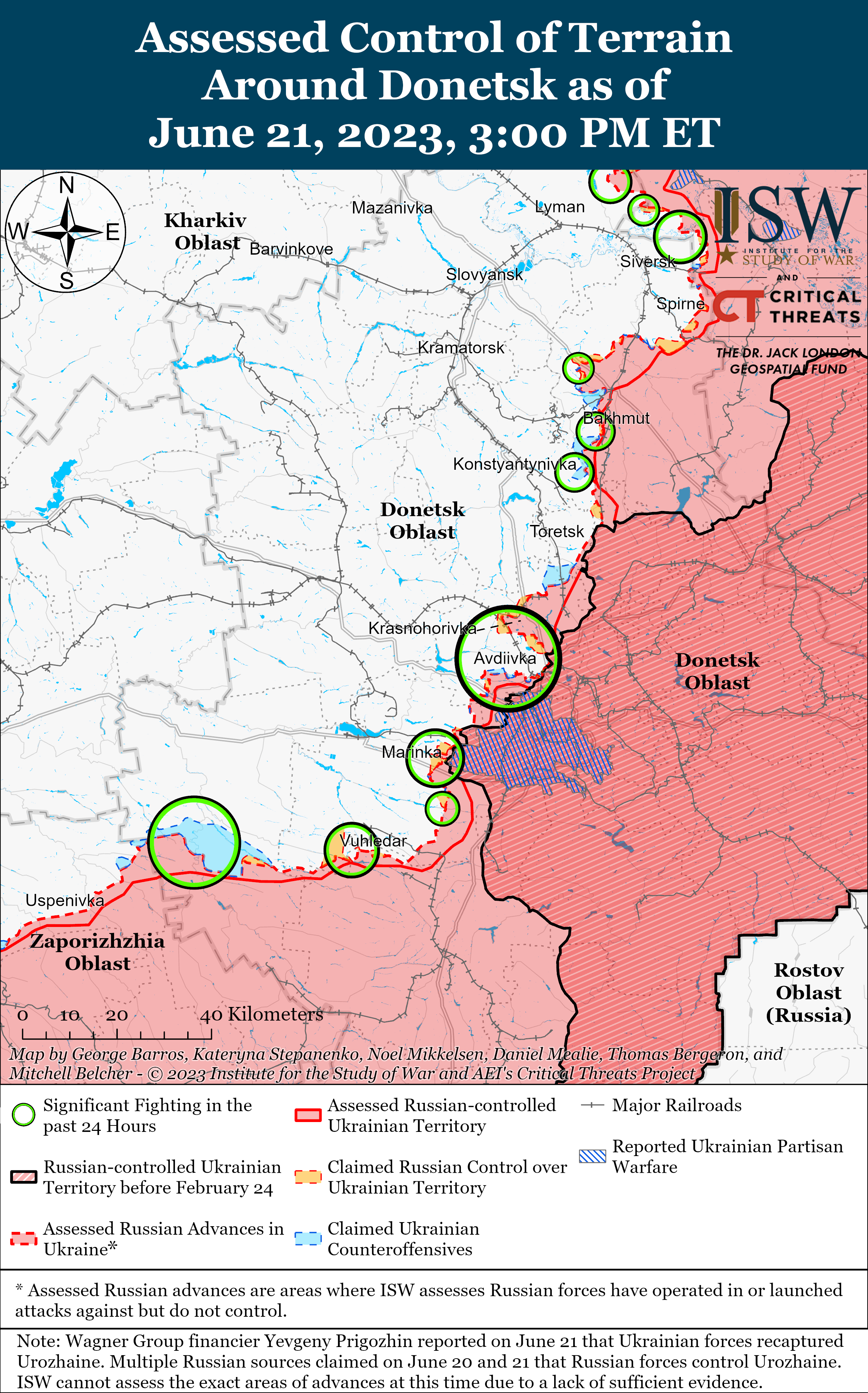
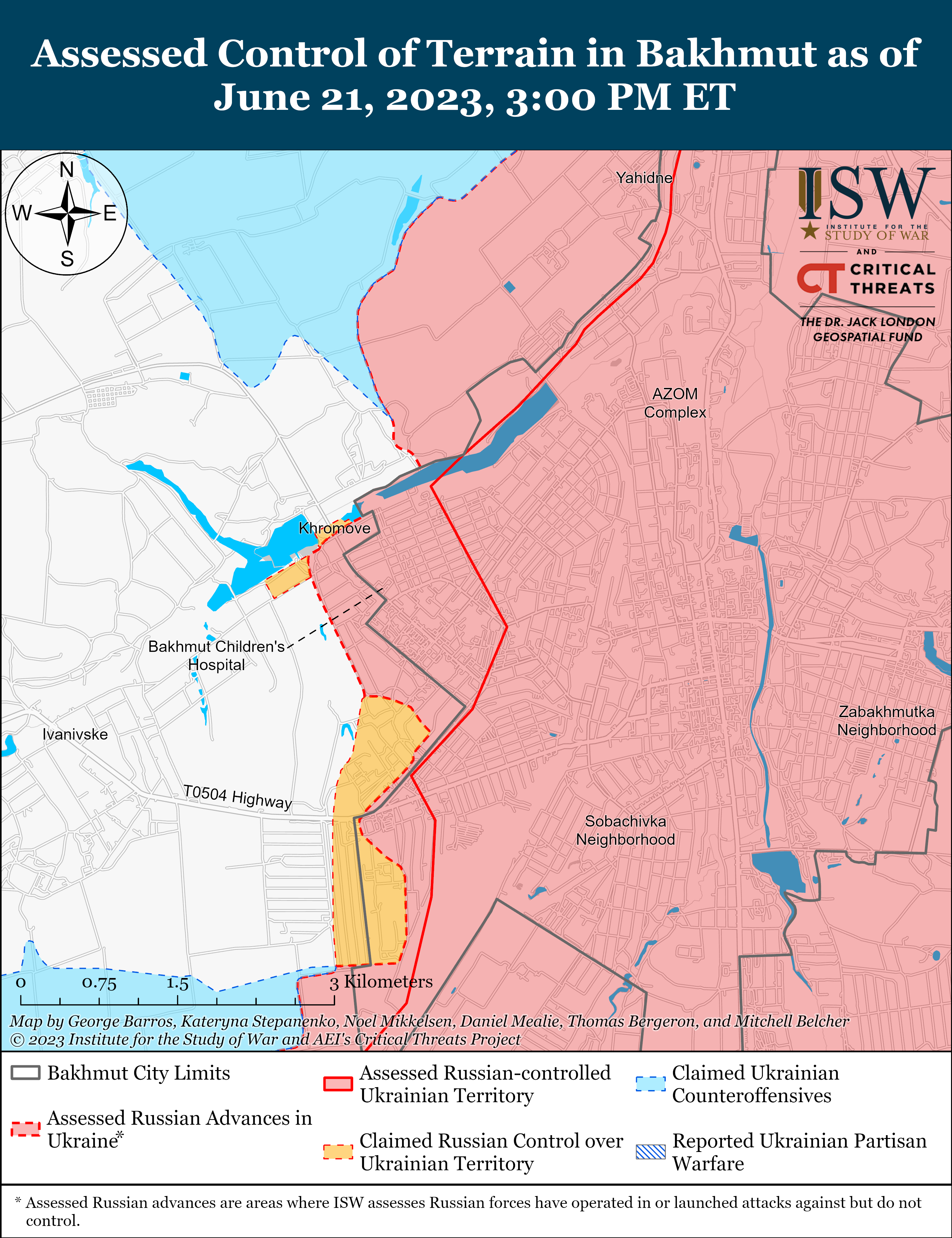
Russian Supporting Effort – Southern Axis (Russian objective: Maintain frontline positions and secure rear areas against Ukrainian strikes)
Russian forces conducted limited ground attacks in the Vuhledar area on June 21. The Ukrainian General Staff reported that Russian forces conducted unsuccessful offensive actions near Vuhledar.[l]
Ukrainian forces conducted limited ground attacks along the administrative border between western Donetsk and eastern Zaporizhia oblasts on June 21. The Ukrainian General Staff reported that Ukrainian forces are conducting offensive operations along the Vilne Pole-Makarivka line (up to 7km south of Velyka Novosilka).[li] Russian sources claimed that Ukrainian forces conducted unsuccessful offensive operations south, southwest, and southeast of Velyka Novosilka.[lii] Russian milbloggers claimed that Ukrainian forces are attacking Urozhaine (10km south of Velyka Novosilka), and Wagner Group financier Yevgeny Prigozhin claimed that Ukrainian forces have already liberated the settlement.[liii] ISW has not observed visual confirmation that Ukrainian forces have liberated Urozhaine. Geolocated footage published on June 21 purportedly shows elements of the 3rd Battalion of the 60th Separate Motorized Rifle Brigade (5th Combined Arms Army, Eastern Military District) operating near Makarivka (6km southeast of Velyka Novosilka) and the “Kaskad” Operational Combat Tactical Formation (a Donetsk People’s Republic formation) operating near Urozhaine.[liv] Footage published on June 21 purportedly shows the 40th Naval Infantry Brigade (Pacific Fleet) operating near Novodonetske (10km southeast of Velyka Novosilka).[lv] Russian and Ukrainian forces conducted limited ground attacks in western Zaporizhia Oblast on June 21.
The Ukrainian General Staff reported that Russian forces conducted unsuccessful offensive operations in the Pyatykhatky direction (25km southwest of Orikhiv).[lvi] ISW geolocated footage published on June 21 that shows continued Ukrainian control of Pyatykhatky.[lvii] Some Russian sources claimed that Russian forces control Pyatykhatky, and others Russian sources claimed that neither Russian nor Ukrainian forces control the settlement.[lviii] A Russian milblogger claimed that Russian forces are attempting to recapture Pyatykhatky from positions in Zherebyanky (27km southwest of Orikhiv.[lix] The Ukrainian General Staff reported that Ukrainian forces are conducting offensive operations along the Novodanylivka-Robotyne (6km south of Orikhiv to 15km south of Orikhiv) and Mala Tokmachka-Verbove (9km southeast of Orikhiv to 20km southeast of Orikhiv) lines.[lx] Ukrainian Deputy Defense Minister Hanna Malyar reported that Ukrainian forces are continuing to conduct offensive operations in southern Ukraine with partial success, consolidating gained positions, and leveling the frontline.[lxi] Prigozhin claimed that Ukrainian forces control Pyatykhatky and areas north of Robotyne (15km south of Orikhiv).[lxii] Russian sources claimed that Ukrainian forces conducted offensive operations near Robotyne and Zherebyanky.[lxiii] Footage published on June 21 purportedly shows elements of the 292nd Self-Propelled Artillery Regiment and 429th Motorized Rifle Regiment (both of the 19th Motorized Rifle Division, 58th Combined Arms Army, Southern Military District) and the “Crimea” and “Sudoplatov” volunteer battalions operating near Pyatykhatky.[lxiv]
Russian sources claimed that Ukrainian forces conducted a missile strike against a Russian rear position in Zaporizhia Oblast. Russian sources claimed that Ukrainian forces conducted a HIMARS strike on Rozivka, about 65km northwest of Mariupol in eastern Zaporizhia Oblast.[lxv]
Prigozhin claimed that Ukrainian forces are attempting to cross the Dnipro River in the Hola Prystan (12km southwest of Kherson City) area. ISW has not observed visual evidence to support his claim.
The UK Ministry of Defense (MoD) reported that Russian forces continue to construct defensive lines to protect occupied Crimea. The UK MoD reported that Russian forces have built a 9km-wide defensive zone about 3.5km north of Crimea.[lxvi] ISW has previously reported on Russian forces constructing defensive lines in northern Crimea and continues to assess that the construction of fortifications in Crimea may suggest that Russian forces are unsure of their ability to hold occupied territory in southern Ukraine.[lxvii]
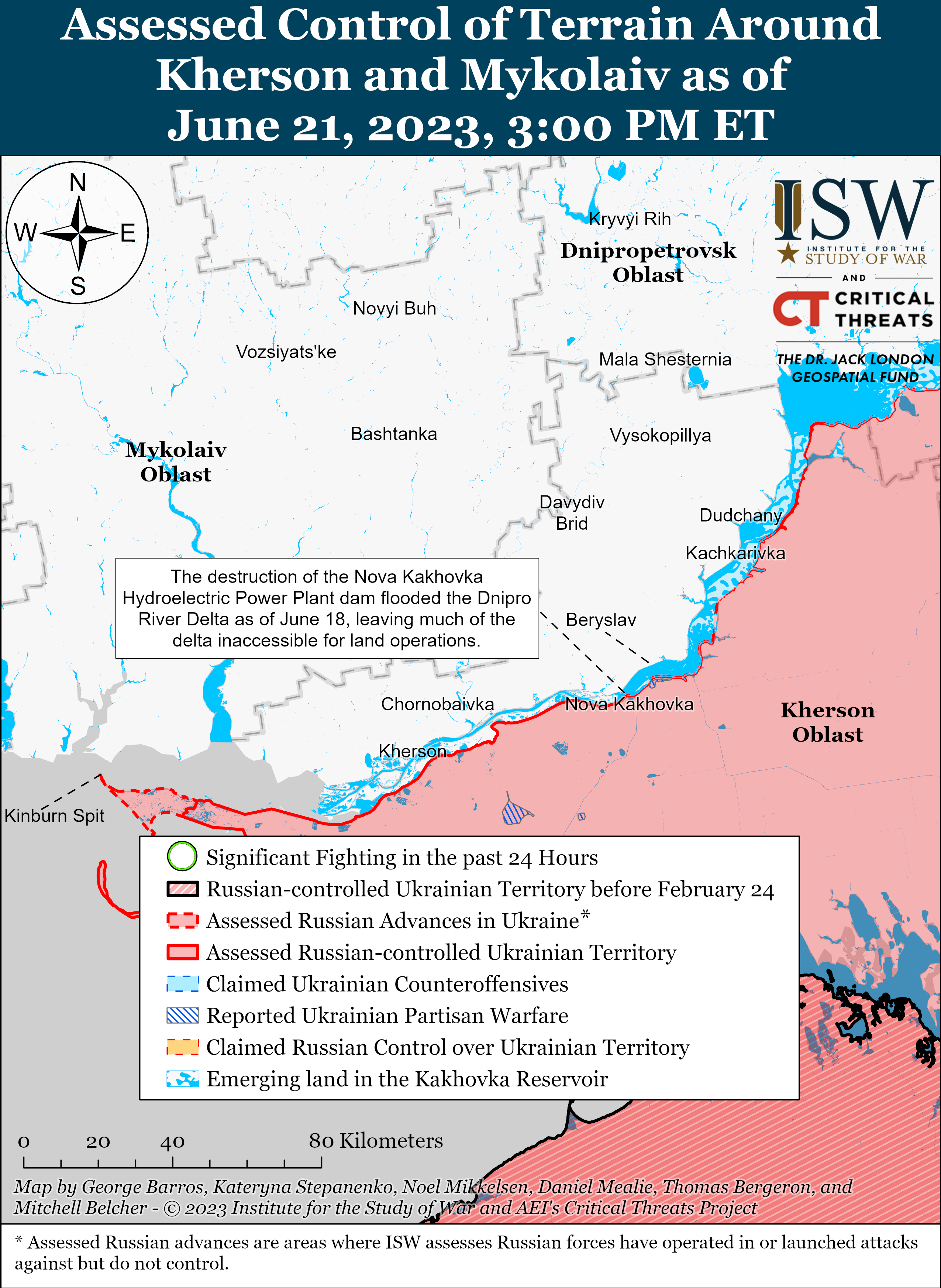
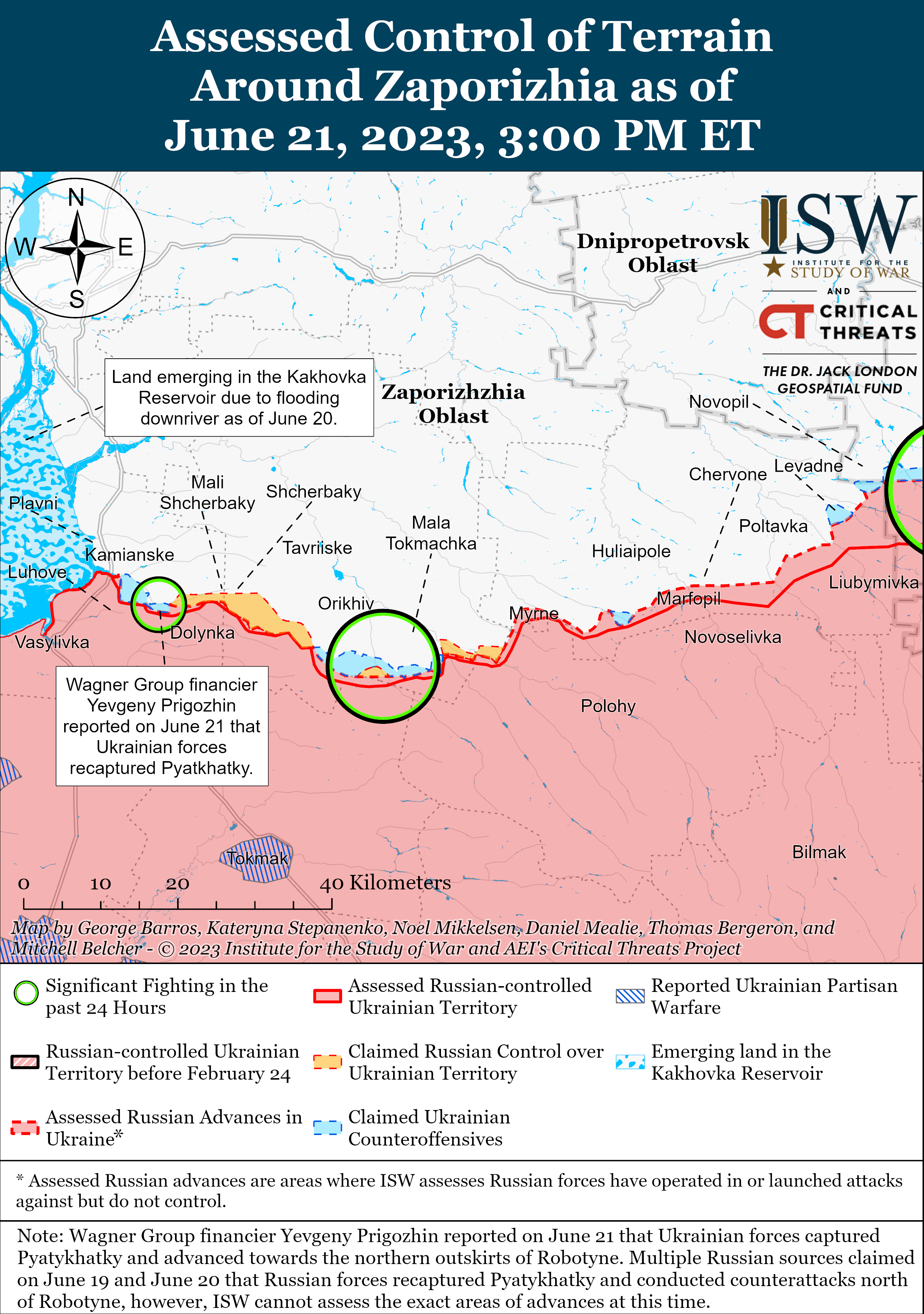
Russian Mobilization and Force Generation Efforts (Russian objective: Expand combat power without conducting general mobilization)
The Russian military command will reportedly form the Azov Naval District as part of the Russian Black Sea Fleet by July 1. The Ukrainian Resistance Center reported that the Russian forces are establishing the Azov Naval District headquarters in occupied Mariupol, and plan to complete its formation by July 1.[lxviii] The Resistance Center added that the Russian military command plans to rebase eight warships and boats, as well as 16 support vessels, from the Russian Black Sea Fleet and the Caspian Flotilla to the Azov Naval District. The center added that these ships include three small missile ships – “Zyklon,” “Askold,” and “Amur” - which will have a total of 24 Kalibr missiles.
The Russian federal government adopted and approved several laws changing contract service procedures on June 21. The Russian State Duma adopted a law in the third reading that increases age limitations for contract servicemen during the period of mobilization, martial law, and wartime.[lxix] High-ranking officer to colonel generals will serve until age of 70, and all other contract servicemen will be able to retire at 65 years of age - likely essential to keep many aging Russian General Officers in their positions without needing special exemptions.[lxx] The Russian Federation Council approved a law that allows individuals who committed crimes of “small or medium gravity” and men of limited fitness for military service to sign military contracts with the Russian MoD.[lxxi]
A prominent Russian milblogger claimed that the Russian presidential order extending social benefits to Russian veterans excludes provisions for the “Storm Z” assault units composed of convicts. The milblogger noted that these convicts practically do not have any rights despite volunteering to fight in Ukraine and that they sign a separate contract with the Russian MoD.[lxxii]
Russian elite airborne forces (VDV) reportedly suffer problems with morale on the frontlines. A Russian source amplified a document claiming that 325 servicemen of the 83rd Guards Air Assault Brigade have left their positions since February 2023.[lxxiii] Russian officials reportedly found 228 of the servicemen while 97 are still missing. ISW previously observed elements of the Russian 83rd Guards Air Assault Brigade in Zaporizhia Oblast as of March 2023.[lxxiv]
Wagner Group financier Yevgeny Prigozhin confirmed that Wagner is recruiting gamers to operate drones.[lxxv] Russian opposition media began reporting on June 19 that Wagner was disseminating recruitment messages for people with ”gaming experience” to join Wagner as UAV specialists.[lxxvi]
Activities in Russian-occupied areas (Russian objective: Consolidate administrative control of annexed areas; forcibly integrate Ukrainian civilians into Russian sociocultural, economic, military, and governance systems)
Russian occupation authorities continue to deport children from occupied Luhansk Oblast to Russia under the guise of medical necessity. Ukrainian Luhansk Oblast Head Artem Lysohor stated on June 20 that Russian occupation authorities have taken 150 children from Starobilsk Raion, occupied Luhansk Oblast to Russia under the guise of “rehabilitation” thus far in June.[lxxvii] Lysohor reported that doctors from Russia examined children in occupied Luhansk Oblast and claimed to find unspecified “pathologies” in 70 percent of children, using these “pathologies” as justification to deport the children to Russia for medical treatment and rehabilitation.[lxxviii] Lysohor also noted that Russian authorities in Starytsia Luhanska are deporting children and their mothers to Russia, likely in support of a large line of effort to forcibly depopulate areas of occupied Ukraine.[lxxix]
The Crimea-based Atesh partisan group reportedly conducted an attack on a railway in occupied Crimea on June 21. Crimean occupation head Sergey Aksyonov reported on June 21 that unspecified actors damaged a railway track near Feodosiya in southeastern Crimea.[lxxx] The Ukrainian Resistance Center attributed the attack to the Atesh partisan movement and noted that the damage disrupted important railway logistics lines that run through the occupied Crimean Peninsula.[lxxxi]
Significant activity in Belarus (Russian efforts to increase its military presence in Belarus and further integrate Belarus into Russian-favorable frameworks).
ISW will continue to report daily observed Russian and Belarusian military activity in Belarus, as part of ongoing Kremlin efforts to increase their control over Belarus and other Russian actions in Belarus.
Ukrainian Main Military Intelligence Directorate (GUR) Head Kyrylo Budanov stated on June 21 that Ukrainian intelligence has not observed information corroborating Russian President Vladimir Putin’s June 16 announcement that Russia transferred tactical nuclear weapons to Belarus.[lxxxii] Budanov stated that Belarusian and Russian forces are continuing to prepare facilities in Belarus for storing Russian tactical nuclear warheads.[lxxxiii] ISW will likely not be able to independently verify when Russian forces transfer tactical nuclear weapons to Belarus but will continue to cover rhetoric surrounding the issue.
Note: ISW does not receive any classified material from any source, uses only publicly available information, and draws extensively on Russian, Ukrainian, and Western reporting and social media as well as commercially available satellite imagery and other geospatial data as the basis for these reports. References to all sources used are provided in the endnotes of each update.
View Citations